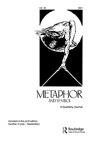“Heavy of Mouth” and “Heavy of Tongue”: Weight as a Conceptual Metaphor of Disability
IF 3.3
3区 文学
0 LANGUAGE & LINGUISTICS
引用次数: 1
Abstract
ABSTRACT We suggest that disability is metaphorically represented in people’s minds as heaviness. In three studies we demonstrate the existence of a mental association between physical weight (light vs. heavy) and disability (non-disabled vs. disabled) as well as its bi-directional causal effects (from weight to disability and from disability to weight). In Study 1 (N = 250), participants exhibited the hypothesized association between the dimensions on both a direct and an indirect measure. Study 2 (N = 191) demonstrated that perceived weight affects the perceived severity of a disability, with the weight of a clipboard held by participants affecting perceptions of a target person’s stutter or limp. Study 3 (N = 103) testified to the reverse effect: participants who heard a monologue by someone with a pronounced (as opposed to mild) stutter perceived the clipboard they were holding as heavier and estimated its weight in grams as higher. Our findings may suggest that experiences of weight affect both estimates of the prevalence of disabilities in others and in the self as well as level of identification with the disabled. Theoretical implications are discussed as well.“嘴重”与“舌重”:体重作为残疾的概念隐喻
摘要我们认为,残疾在人们心目中被比喻为沉重。在三项研究中,我们证明了身体重量(轻与重)和残疾(非残疾与残疾)之间存在心理联系,以及其双向因果效应(从体重到残疾和从残疾到体重)。在研究1(N=250)中,参与者在直接和间接测量中都表现出假设的维度之间的关联。研究2(N=191)表明,感知到的体重会影响感知到的残疾严重程度,参与者持有的剪贴板的重量会影响对目标人口吃或跛行的感知。研究3(N=103)证明了相反的效果:参与者听到有明显(而不是轻微)口吃的人的独白时,会觉得他们拿的剪贴板更重,并估计它的重量(克)更高。我们的研究结果可能表明,体重经历会影响对他人和自我残疾患病率的估计,以及对残疾人的认同程度。还讨论了理论含义。
本文章由计算机程序翻译,如有差异,请以英文原文为准。
求助全文
约1分钟内获得全文
求助全文
来源期刊

Metaphor and Symbol
Multiple-
CiteScore
2.90
自引率
0.00%
发文量
23
期刊介绍:
Metaphor and Symbol: A Quarterly Journal is an innovative, multidisciplinary journal dedicated to the study of metaphor and other figurative devices in language (e.g., metonymy, irony) and other expressive forms (e.g., gesture and bodily actions, artworks, music, multimodal media). The journal is interested in original, empirical, and theoretical research that incorporates psychological experimental studies, linguistic and corpus linguistic studies, cross-cultural/linguistic comparisons, computational modeling, philosophical analyzes, and literary/artistic interpretations. A common theme connecting published work in the journal is the examination of the interface of figurative language and expression with cognitive, bodily, and cultural experience; hence, the journal''s international editorial board is composed of scholars and experts in the fields of psychology, linguistics, philosophy, computer science, literature, and media studies.
 求助内容:
求助内容: 应助结果提醒方式:
应助结果提醒方式:


